
Next American City published my account of St. Louis’ recent preservation triumphs of the “flying saucer” Starbucks and the AAA Building. Read the full article: Starbucks in a Flying Saucer: STL Preservationists Embrace Modernism. – Michael R. Allen

Next American City published my account of St. Louis’ recent preservation triumphs of the “flying saucer” Starbucks and the AAA Building. Read the full article: Starbucks in a Flying Saucer: STL Preservationists Embrace Modernism. – Michael R. Allen
by Michael R. Allen
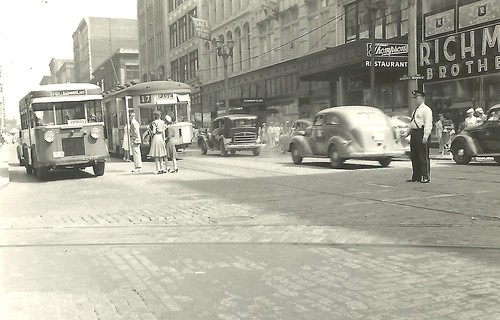
CVS’ announcement that it has abandoned its quest to demolish the mid-century modern AAA Building on Lindell Boulevard comes nearly one century after the first time St. Louis learned that an ambitious chain drug store from Indianapolis was looking for sites here. The August 1914 issue of The Pharmaceutical Era reported that Indianapolis-based Hook Drug Company was opening a store at 616 Washington Avenue and intended to become St. Louis’ first drug store chain. Hook Drug Company was a relatively new company, having been founded by pharmacist John A. Hook in 1900. Hook and partner Edward Roesch served a German-American neighborhood in Indianapolis in a corner shop, but had added another eleven stores in that city by 1912.
Yet Hook Drug never opened the Washington Avenue store or any others in St. Louis. For some reason, the chain backed away from entry into this market. Hook Drug Company would grow as a prominent chain in the Midwestern market, with stores branded as “Hook’s Drugs.” By 1985, Hook’s was purchased by Kroger, and entered into a series of sales until the chain went defunct after a 1994 purchase by Revco. In 1997, CVS purchased Revco, and converted many Hook’s stores into CVS outlets.

St. Louis had no want for drug stores. In 1914, at least 28 St. Louis drug stores had multiple locations. The first chain drug store, a Walgreen’s, would not open until 1926. Walgreens entered the market with force, opening stores at 500 DeBalievere, 6100 Easton, 515 Olive, 360 N. Skinker, 514 and 725 Washington and 5501 Pershing. Indianapolis-based CVS opened its first store in St. Louis in 2010.
Later, the building at 616 Washington was demolished for the St. Louis Centre, which opened in 1985 with a Walgreens store inside the shopping mall. That store closed in 2006. Today, St. Louis Centre has been reconstructed as a parking garage with ground-level retail named the MX. Rumors surfaced that CVS was looking at the MX building for a downtown store, but so far has not signed a lease.
by Michael R. Allen
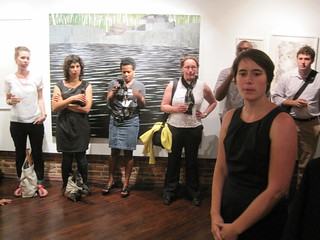
I am a Next American Vanguard alum, having been part of the 2010 “class” that met in that eastern outpost of solidly red brick neighborhoods, Philadelphia. In two days, we spent time taking in talks from the city’s experts in public policy, touring urban farms, abandoned waterfront sites and innovative small businesses, and learning about — and from — each other. Getting into conversations with peer practitioners from other disciplines and cities, I felt like my work in St. Louis was connected to a national movement to make our cities better. I also learned about my work — that it was something different to an education reform advocate from Los Angeles than to a City Councilman in Portland, Maine. Since 2010, the people I met at Next American Vanguard have shared ideas and articles, given me places to stay, connected me to colleagues in my field and provided advice.
While in St. Louis, Vanguard attendees will see what this city is doing right, and wrong. They will visit neighborhoods, the City Museum, the Regional Arts Commission and a downtown rooftop loft. They will hear from Mayor Francis Slay, from vanguard alums, Amos Harris, Richard Baron and Joe Edwards. Yet most of all they will find each other, peers who will invigorate their work with new perspectives. St. Louis is lucky to be the scene for the conversation at Next American Vanguard.
Who knows — maybe the city will shine brightly enough that a Vanguard or two will end up living here in the next few years. Maybe some people will leave us with a new idea or a potent, useful critique. At the very least, everyone will return to their cities knowing that St. Louis definitely is part of the national discussion on the future of American cities.
by Michael R. Allen
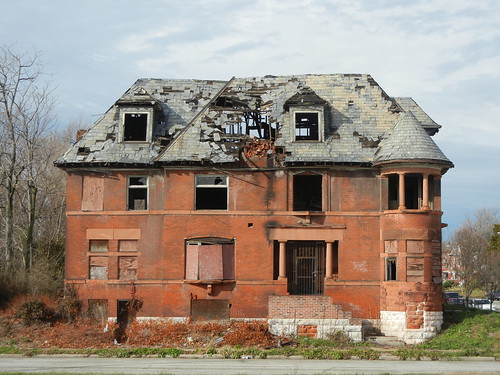
Although heavily deteriorated, and possessed by a shadowy real estate speculator, the lonely large residence at the southwest corner of Cook and Whittier avenues remains a stunning example of local Richardsonian Romanesque residential design. The house was built around 1892, with its definite architect a mystery and its origin enmeshed in a design exercise whose details are also elusive. Underneath a high-pitched slate-clad hipped roof with dormers is a two-story brick building on raised basement. A curious corner bow is open at the second story, framed by Iowa sandstone elements and rising to an intersecting rounded hip.
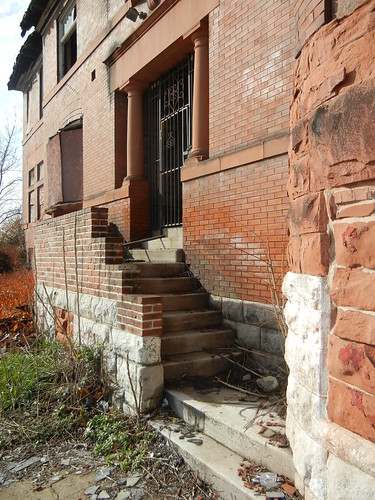
Open Streets comes to Southwest Garden this Saturday morning, and we are joining in with a tour:
Architectural Tour of Reber Place
Saturday, September 29 at 9:30 a.m.
Meet at west end of Reber Place at Hereford Avenue (both streets closed for Open Streets)
With its central median and large 19th century single dwellings, Reber Place might have passed for one of the city’s private streets. Yet historical development included the city’s largest clay sewer pipe works, a Roman Catholic parish complex, apartment buildings and bungalows. Today the one-block stretch of Reber Place west of Tower Grove Park contains a range of architectural styles and building types on a green, park-like street. Michael R. Allen will offer a short walk along Reber Place.
More information here.
City Seminar presents
“When Should Cities Go Away?”
Thursday, September 28 at 2:30 p.m.
Washington University in St. Louis, Danforth Campus, Busch Hall, Room 18
With guest speaker
Andrew Theising
Associate Professor, Department of Political Science
Director, Institute for Urban Research,
Southern Illinois University-Edwardsville
Light refreshments/ reception and discussion afterwards.
Generously sponsored by the American Culture Studies Program (AMCS) at Washington University.
City Seminar is a forum in which scholars across disciplines and from colleges and universities in the St. Louis area can share ideas, research methods, theories and topics on anything related to urban studies in the United States and abroad. At each meeting, a scholar presents some work in progress and then we have an informal discussion of the work, accompanied by drinks and snacks.
We hope this forum will help to build an intellectual community around urban scholarship and urban politics.
by Michael R. Allen
Today’s Preservation Board meeting will be the first for its newest member, Alderman Craig Schmid (D-20th). Schmid recently was elected to serve as Chairman of the Public Safety committee of the Board of Aldermen, following the untimely death of previous chair Alderman Greg Carter (D-27th). Under the specifications of Preservation Board composition in the city’s preservation ordinance, the Chairman of the Aldermanic Public Safety Committee is a voting member of the Preservation Board.
Schmid’s vote largely replaces that of Alderman Antonio French (D-21st), who attended Preservation Board meetings in the last two years as the designee of Alderman Carter. French voted against nearly every demolition request that appeared before the board, including those for Sts. Mary and Joseph School (now completely demolished) and the AAA Building (now off the chopping block under a new CVS plan). French surprised some when he voted on the minority side of the 3-2 vote in November 2011 that blocked St. Louis University’s request to demolish of the Pevely Dairy Plant’s corner office building at Chouteau and Grand. French, however, stated that because the university planned a new ambulatory care facility on the site he could support the plan. Alderman French opposed demolition without plans for replacement development.
Schmid has appeared before the board multiple times, most often opposed to demolitions in his ward. In 2009, Schmid led a march against the St. Louis Public Schools’ planned closure of several south side schools, including Shepard School in Marine Villa. Additionally, Schmid has been one of a few aldermen actually willing to repair brick alleys rather than pave over them. Schmid most recently appeared at the board in June in the matter of a city-owned frame flounder house at 3719 Texas Avenue, and agreed to a six-month window of time to find a reuse plan before considering demolition again.
Had Wells Fargo not removed its appeal of a denied demolition permit for the building at 3006-8 Cherokee Street, Schmid’s first demolition vote might have considered a matter in his own ward. In the future he may well get more chances to shape the outcome of demolition matters in neighborhoods like Gravois Park which reside within his ward and have high rates of vacancy.
by Emily Kozlowski

The three brick townhouses of 1349-1353 N. Garrison Ave. were once a staple of the neighborhood, as the community grocery store named Tillie’s Corner. Lillie Pearson, known as “Miss Tillie”, bought the first building in 1948 and operated a successful business there for 40 years. Her long-lived business is a testament to Lillie herself, as a single mother and an African American woman in a severely segregated city. The townhouses are historic links to the migration of African Americans from the south to northern urban centers, to a business owned and operated by an African American woman, and to the community center for which the store is essentially remembered (hours 5:00 a.m. – 11:00 p.m.).
The Late Victorian style townhouses of Tillie’s Corner were built in 1870 in the residential neighborhood of Jeff-VanderLou. Three stories tall and with three separate store fronts added in the 1920’s, they were built with home and business in mind. Lillie opened shop after the sudden death of her husband left her with the children to support on her own. Her shop was her way of supporting her family and being a part of the community. The confectionery thrived from the neighboring Dunbar Elementary School and local homeowners. Lillie devotedly kept daily hours that were much longer than any large grocer, allowing for those without transportation to stop by after work. Her hours extended to years, and the shop was running for a remarkable four decades. Lillie can be considered an activist in community building, as she stayed at the exact same address through years of increasing crime and urban decline. She offered a stable business to meet the needs of her neighborhood instead of abandoning it. After 40 years, only when she was physically unable to operate the business, did she close Tillie’s Corner.

Carla Pearson and Miguel Alexander, heirs of Tillie’s Corner, have high hopes for the future. Not only do they look to preserve the buildings, but plan on using them as a center for care-giving to the elderly and disabled. Tillie’s Corner is currently in the process of being listed in the National register of Historic Places (thanks to students in Dr. Sonia Lee’s Washington university history courses, with pro bono assistance from Karen Bode Baxter). The problem, now, is restoring the buildings to their history glory. They have deteriorated and weathered over time; recently, a side of the building collapsed due to heavy rain. The buildings can be saved but time is the crucial factor. Help preserve a part of St. Louis and African American history by donating or spreading the story. Carla and Miguel can be contacted at (314) 495-3686 or tilliescorner@yahoo.com.
Emily Kozlowski, an art history major at Webster University, is currently a Research Intern at Preservation Research Office.
by Michael R. Allen
Vacant lots silently are starting to multiply on the city’s “state streets,” especially in parts of Gravois Park and Dutchtown between promising business districts on Cherokee Street and Meramec Avenue. Even worse are the innumerable signs of future trauma: bleached-red plywood, windows gasping through shards of broken glass, front doors hung ajar, downspouts and gutter pans already smelted in blast furnaces outside Beijing and weeds that cannot be cut enough to stay low. While much attention has been shed on vacancy’s impact on the north side, the south side is showing the signs of a future crisis.
Foreclosure has been a huge factor making neglect more difficult to sustain. As waves of investors abandoned underwater multi-family buildings, the vacancy rates soared in Benton Park West, Gravois Park, Dutchtown and other neighborhoods. In 2008, the federal Department of Housing and Urban Development awarded the city a $5.6 million grant to purchase and rehabilitate foreclosed homes. Under the direction of then-Deputy Mayor for Development Barbara Geisman, the city’s Community Development Administration targeted those funds in Gravois Park, Benton Park West and Dutchtown. At the time, the city projected the purchase of 87 homes and an application to receive $10 million toward purchasing 231 more.
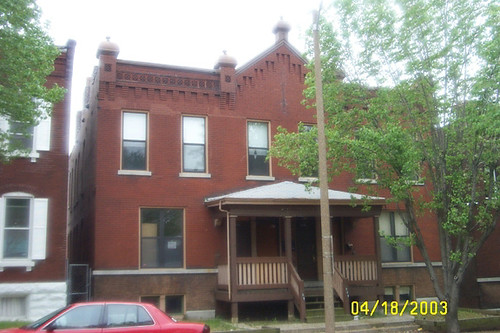
by Michael R. Allen
In my capacity as President of Modern STL, I just sent out the following call to action.
As we near the November 6 election, the demolition threat to the Lewis and Clark Branch remains. (Read up on the issue here.) Landmarks Association of St. Louis placed the Lewis and Clark Branch on their 2012 Most Endangered Places list this fall, and the press has run a slew of articles highlighting the building’s significance and possible fate.
Still, the St. Louis County Library will not pledge to take way demolition as an option for the Lewis and Clark Branch under its proposed $108 million facilities plan. Director Charles Pace has recommended a study for reuse be done, but at the moment anyone who supports the St. Louis County Library bond issue may be supporting destroying one of the region’s finest Modern buildings.